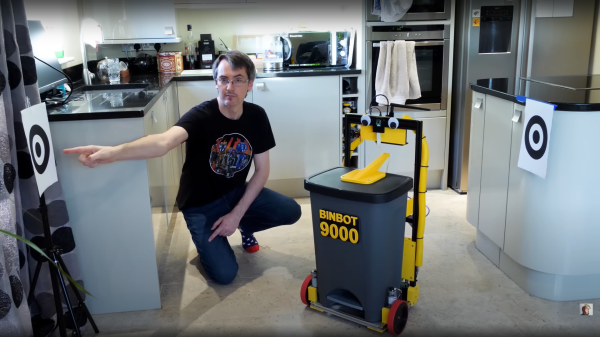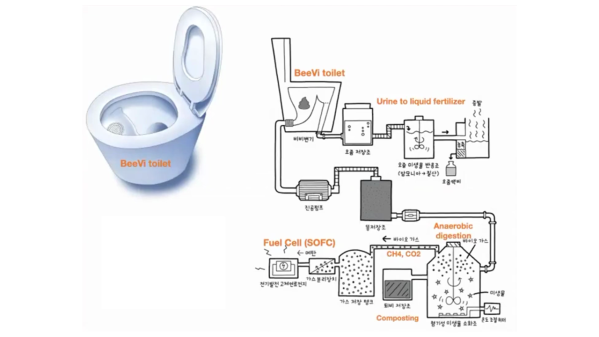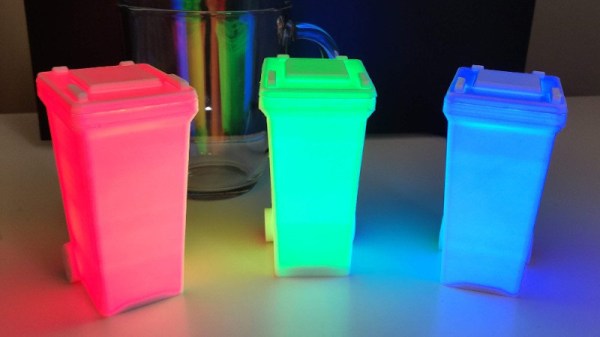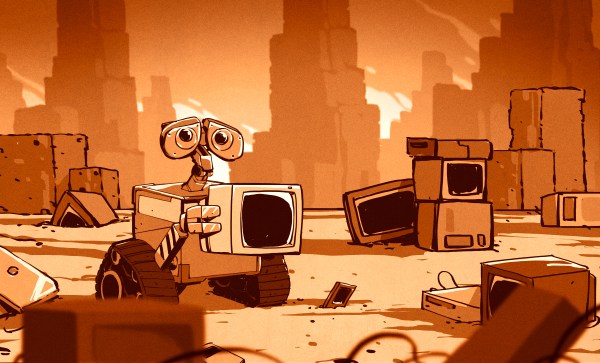Many of us have been asking for some time now “where are our robot servants?” We were promised this dream life of leisure and luxury, but we’re still waiting. Modern life is a very wasteful one, with items delivered to our doors with the click of a mouse, but the disposal of the packaging is still a manual affair. Wouldn’t it be great to be able to summon a robot to take the rubbish to the recycling, ideally have it fetch a beer at the same time? [James Bruton] shares this dream, and with his extensive robotics skillset, came up with the perfect solution; behold the Binbot 9000. (Video, embedded below the break)
waste23 Articles
Modern Toilet Generates Energy
Environmental Engineering [Prof Jaeweon Cho] at South Korea’s Ulsan National Institute of Science and Technology specializes in water and waste management. He has developed an energy-generating toilet called BeeVi (pronounced beevee) that recycles your waste in three ways. Liquid waste is processed in a microbial reaction tank to make a liquid fertilizer. Solid waste is pumped into an anaerobic digestion tank, which results in methane gas used to power a silicone oxide fuel cell to make electricity. The remaining solids are composted to make fertilizer. The daily waste from one person is about 500 g, which can generate about 50 L of methane.
The BeeVi toilets, located on the UNIST campus, pay students in a digital currently called Ggools, or Honey Money in English. Each deposit earns 10 Ggools, which can be used to purchase coffee, instant noodles, and other items (one Ggool is equivalent to about $3.00 value). The output from this pilot project is used to partially power the building on campus, and to fertilize gardens on the grounds. If you want to learn more, here is a video lecture by [Prof Cho] (in English).
Waste management is an area of research around the world. The Gates Foundation has been funding research into this field for ten years, and has held a number of expos over the years highlighting innovative solutions, most recently being the 2018 Reinvent the Toilet Expo in Beijing. We wrote a piece about the future of toilets last year as well.
Recovering Metal From Waste
Refining precious metals is not as simple as polishing rocks that have been dug out of the ground. Often, complex chemical processes are needed to process the materials properly or in high quantities, but these processes leave behind considerable waste. Often, there are valuable metals left over in these wastes, and [NerdRage] has gathered his chemistry equipment to demonstrate how it’s possible to recover these metals.
The process involved looks to recover copper and nitric acid from copper nitrate, a common waste byproduct of processing metal. While a process called thermal decomposition exists to accomplish this, it’s not particularly efficient, so this alternative looks to improve the yields you could otherwise expect. The first step is to react the copper nitrate with sulfuric acid, which results in nitric acid and copper sulfate. From there, the copper sulfate is placed in an electrolysis cell using a platinum cathode and copper anodes to pass current through it. After the process is complete, all of the copper will have deposited itself on the copper electrodes.
The other interesting thing about this process, besides the amount of copper that is recoverable, is that the sulfuric acid and the nitric acid are recoverable, and able to be used again in other processes. The process is much more efficient than thermal decomposition and also doesn’t involve any toxic gasses either. Of course, if collecting valuable metals from waste is up your alley, you can also take a look at recovering some gold as well.
Thanks to [Keith] for the tip!
Hackaday Links: June 28, 2020
You can imagine how stressful life is for high-power CEOs of billion-dollar companies in these trying times; one is tempted to shed a tear for them as they jet around the world and plan their next big move. But now someone has gone and upset the applecart by coming up with a way to track executive private jets as they travel across North America. This may sound trivial, but then you realize that hedge fund managers pay big money for the exact same data in order to get an idea of who is meeting with whom and possibly get an idea of upcoming mergers and acquisitions. It’s also not easy, as the elites go to great lengths to guard their privacy. Luckily, the OpenSky Network lists all ADS-B traffic its web of ground stations receives, unlike other flight monitoring sites which weed out “sensitive” traffic. Python programs scrape the OpenSky API and cross-reference plane registrations with the FAA database to see which company jets are doing what. There are plenty of trips to Aspen and Jackson Hole to filter out, but with everyone and his little brother fancying themselves a day trader lately, it’s another tool in the toolbox.
We got a nice note from Michelle Thompson this week thanking us for mentioning the GNU Radio Conference in last week’s Links article, and in particular for mentioning the virtual CTF challenge that they’re planning. It turns out that Michelle is deeply involved in designing the virtual CTF challenge, after having worked on the IRL challenges at previous conferences. She shared a few details of how the conference team made the decision to go forward with the virtual challenge, inspired in part by the success of the Hack-A-Sat qualifying rounds, which were also held remotely. It sounds like the GNU Radio CTF challenge will be pretty amazing, with IQ files being distributed to participants in lieu of actually setting up receivers. We wish Michelle and the other challenge coordinators the best of luck with the virtual con, and we really hope a Hackaday reader wins.
Amateur radio is often derided as a hobby, earning the epithet “Discord for Boomers” according to my son. There’s more than a grain of truth to that, but there are actually plenty of examples where a ham radio operator has been able to make a big difference in an emergency. Case in point is this story from the Western Massachusetts ARRL. Alden Jones (KC1JWR) was hiking along a section of the Appalachian Trail in southern Vermont last week when he suddenly got light-headed and collapsed. A passing hiker who happened to be an emergency medical technician rendered aid and attempt to contact 911 on his cell phone, but coverage was spotty and the dispatcher couldn’t hear him. So Alden, by this point feeling a little better, pulled out his handy talkie and made an emergency call to the local repeater. Luckily the Western Massachusetts Traffic Net was just about to start, so they went into emergency mode and coordinated the response. One of the hams even went to the rescue staging area and rigged up a quick antenna to improve the signal so that rescuers could finally get a helicopter to give Alden a ride to the hospital. He’s fine now, and hats off to everyone who pitched in on the eight-hour rescue effort.
And finally, there are obviously a lot of details to be worked out before anyone is going to set foot on the Moon again. We’ve got Top People™ working on all the big questions, of course, but apparently NASA needs a little help figuring out how and where the next men and first women on the Moon are going to do their business. The Lunar Loo Challenge seeks innovative designs for toilets that can be used in both microgravity and on the lunar surface. There is $35,000 in prize money for entrants in the Technical division; NASA is also accepting entries in a Junior division, which could prove to be highly entertaining.
BinDayCator Lets You Know When To Take Out The Trash
Municipal waste pickup is a wonderful luxury. Typically once a week, large trucks come by and pick up bins of garbage from your residence. All you have to do is remember to put them out! In a uniquely human way, this is very hard to do. Enter the BinDayCator.
The project consists of a 3D printed model of a typical council wheelie-bin. Printed in white filament, the bin is translucent enough to glow when lit by powerful WS2812B LEDs. Having four LEDs both helps fill the entire model with an even light, as well as allows the bin to display multiple colors in different segments. This means that if it’s green bin day, the bin glows green. If it’s the day for the red and blue bins, the indicator will light up segments in red and blue.
Unfortunately there’s no global standard that councils use to serve up bin day data over the Internet, so configuration isn’t as simple as pointing the BinDayCator at your local waste authority’s website. Instead, some Node-RED code is used to scrape the council website once a day and tell the ESP8266 controlling the BinDayCator which bins are due to be placed on the roadside. A later revision has a custom calendar UI that can allow for manual configuration of the relevant days.
The BinDayCator is a cute device, and one that would likely be commercially successful if there were a simple and easy way to configure the necessary data feed. We’d love one by our front door so we didn’t miss another collection day. Visual indicators are always useful, even if its just for checking the mail. Video after the break.
Continue reading “BinDayCator Lets You Know When To Take Out The Trash”
Innovative Bird Feeder Design Recycles Recycling’s Garbage
Recycling beverage cartons isn’t 100% efficient. The process yields some unusable garbage as a byproduct. Why? Because containers like juice boxes are mostly paper, but also contain plastic and aluminum. The recycling process recovers the paper fibers for re-use, but what’s left after that is a mixture of plastic rejects and other bits that aren’t good for anything other than an incinerator or a landfill. Until now, anyway!
It turns out it is in fact possible to turn such reject material into a product that can be injection-molded, as shown here with [Stefan Lugtigheid]’s SAM bird feeder design. The feeder is not just made from 100% recycled materials, it’s made from the garbage of the recycling process — material that would otherwise be considered worthless. Even better, the feeder design has only the one piece. The two halves are identical, which reduces part count and simplifies assembly.
[Stefan] makes it clear that the process isn’t without its quirks. Just because it can be injection-molded doesn’t mean it works or acts the same as regular plastic. Nevertheless, the SAM birdfeeder demonstrates that it can definitely be put to practical use. We’ve seen creative reprocessing of PET bottles and sheet stock made from 3D printed trash, but recycling the garbage that comes from recycling drink cartons is some next-level stuff, for sure.
The Woeful World Of Worldwide E-Waste
How large is the cache of discarded electronics in your home? They were once expensive and cherished items, but now they’re a question-mark for responsible disposal. I’m going to dig into this problem — which goes far beyond your collection of dead smartphones — as well as the issues of where this stuff ends up versus where it should end up. I’m even going to demystify the WEEE mark (that crossed out trashcan icon you’ve been noticing on your gadgets), talk about how much jumbo jets weigh, and touch on circular economies, in the pursuit of better understanding of the waste streams modern gadgets generate.
Our lives are encountering an increasing number of “how do I dispose of this [X]” moments, where X is piles of old batteries, LCDs, desktop towers, etc. This leads to relationship-testing piles of garbage potential in a garage or the bottom of a closet. Sometimes that old gear gets sold or donated. Sometimes there’s a handy e-waste campaign that swings through the neighborhood to scoop that pile up, and sometimes it eventually ends up in the trash wrapped in that dirty feeling that we did something wrong. We’ve all been there; it’s easy to discover that responsible disposal of our old electronics can be hard.
Fun fact: the average person who lives in the US generates 20 kg of e-waste annually (or about 44 freedom pounds). That’s not unique, in the UK it’s about 23 kg (that’s 23 in common kilograms), 24 kg for Denmark, and on and on. That’s quite a lot for an individual human, right? What makes up that much waste for one person? For that matter, what sorts of waste is tracked in the bogus sounding e-waste statistics you see bleated out in pleading Facebook posts? Unsurprisingly there are some common definitions. And the Very Serious People people at the World Economic Forum who bring you the definitions have some solutions to consider too.
We spend a lot of time figuring out how to build this stuff. Are we spending enough time planning for what to do with the gear once it falls out of favor? Let’s get to the bottom of this rubbish.
Continue reading “The Woeful World Of Worldwide E-Waste”

















